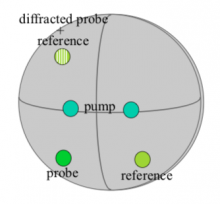
Epitaxial growth of III-V semiconductors on Si is a promising route for silicon photonics. Threading dislo- cations and the residual thermal stress generated during growth are expected to affect the thermal conductivity of the III-V semiconductors, which is crucial for efficient heat dissipation from photonic devices built on this platform. In this work, we combine a noncontact laser-induced transient thermal grating technique with ab initiophonon simulations to investigate the in-plane thermal transport of epitaxial GaAs-based buffer layers on Si, employed in the fabrication of III-V quantum dot lasers. Surprisingly, we find a significant reduction of the in-plane thermal conductivity of GaAs, up to 19%, as a result of a small in-plane biaxial stress of ∼250 MPa. Using ab initio phonon calculations, we attribute this effect to the enhancement of phonon-phonon scattering caused by the in-plane biaxial stress, which breaks the cubic crystal symmetry of GaAs. Our results indicate the importance of eliminating the residual thermal stress in the epitaxial III-V layers on Si to avoid the reduction of thermal conductivity and facilitate heat dissipation. Additionally, our results showcase potential means of effectively controlling thermal conductivity of solids with external strain/stress.